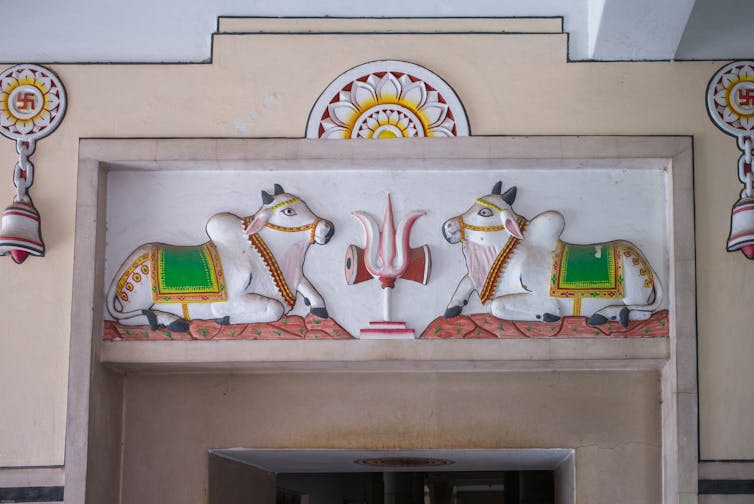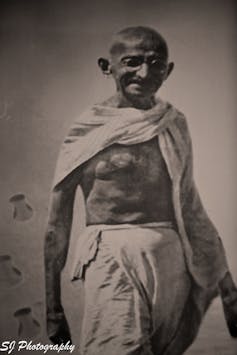Why Do Indians Not Eat Beef or Pork
Just this past June, at a national meeting of various Hindu organizations in Republic of india, a popular preacher, Sadhvi Saraswati, suggested that those who consumed beefiness should exist publicly hanged. Later, at the same conclave, an animal rights activist, Chetan Sharma, said,
"Cow is besides the reason for global warming. When she is slaughtered, something called EPW is released, which is directly responsible for global warming. Information technology's what is called emotional pain waves."
These provocative remarks come at a time when vigilante Hindu groups in India are lynching people for eating beef. Such killings take increased since Narendra Modi and his correct-fly Bharatiya Janata political party came to power in September 2014. In September 2015, a 50-year-old Muslim man, Mohammad Akhlaq, was lynched by a mob in a hamlet near New Delhi on suspicion that he had consumed beef. Since then, many attacks by moo-cow vigilante groups have followed. Modi'south government has as well prohibited the slaughter of buffalo, thus destroying the Muslim-dominated buffalo meat industry and causing widespread economic hardship.
Most people seem to assume that no Hindu has ever consumed beef. Simply is this true?
As a scholar, studying Sanskrit and aboriginal Indian religion for over 50 years, I know of many texts that offering a clear answer to this question.
Cows in ancient Indian history
Scholars have known for centuries that the ancient Indians ate beef. After the 4th century B.C., when the practice of vegetarianism spread throughout Republic of india among Buddhists, Jains and Hindus, many Hindus continued to consume beef.
In the time of the oldest Hindu sacred text, the Rig Veda (c. 1500 B.C.), cow meat was consumed. Like nearly cattle-breeding cultures, the Vedic Indians generally ate the castrated steers, but they would swallow the female person of the species during rituals or when welcoming a guest or a person of high status.
Ancient ritual texts known as Brahmanas (c. 900 B.C.) and other texts that taught religious duty (dharma), from the third century B.C., say that a bull or cow should exist killed to be eaten when a invitee arrives.
According to these texts, "the cow is nutrient." Even when one passage in the "Shatapatha Brahmana" (3.1.2.21) forbids the eating of either cow or bull, a revered ancient Hindu sage named Yajnavalkya immediately contradicts information technology, saying that, notwithstanding, he eats the meat of both cow and balderdash, "every bit long as it'south tender."

It was the Sanskrit ballsy, the Mahabharata (equanimous between 300 B.C. and A.D. 300) that explained the transition to the not eating of cows in a famous myth:
"Once, when there was a nifty famine, King Prithu took up his bow and pointer and pursued the Earth to force her to yield nourishment for his people. The Earth assumed the form of a cow and begged him to spare her life; she and then immune him to milk her for all that the people needed."
This myth imagines a transition from hunting wild cattle to preserving their lives, domesticating them, and breeding them for milk, a transition to agriculture and pastoral life. It visualizes the cow as the paradigmatic beast that yields food without being killed.
Beef-eating and caste
Some dharma texts composed in this same period insist that cows should not be eaten. Some Hindus who did eat meat made a special exception and did not eat the meat of cow. Such people may take regarded beefiness-eating in the light of what the historian Romila Thapar describes as a "matter of status" – the higher the caste, the greater the food restrictions. Diverse religious sanctions were used to impose prohibition on beef eating, but, as Thapar demonstrates, "only among the upper castes."
As I run across it, the arguments confronting eating cows are a combination of a symbolic argument about female purity and docility (symbolized by the cow who generously gives her milk to her calf), a religious argument about Brahmin sanctity (equally Brahmins came increasingly to be identified with cows and to be paid by donations of cows) and a way for castes to ascent in social ranking.
Sociologist G. N. Srinivas pointed out that the lower castes gave upward beef when they wanted to move upwards the social ladder through the procedure known as "Sanskritization."

By the 19th century, the moo-cow-protection motion had arisen. One of the implicit objects of this movement was the oppression of Muslims.
Famously, Gandhi attempted to make vegetarianism, especially the taboo confronting eating beef, a central tenet of Hinduism. Gandhi's attitude to cows was tied to his idea of nonviolence.
He used the epitome of the Earth cow (the i that King Prithu milked) as a kind of Mother Earth, to symbolize his imagined Indian nation. His insistence on cow protection was a major cistron in his failure to attract large-scale Muslim support.
Yet even Gandhi never called for the banning of cow slaughter in India. He said,
"How can I strength anyone non to slaughter cows unless he is himself so disposed? It is not as if in that location were but Hindus in the Indian Marriage. At that place are Muslims, Parsis, Christians and other religious groups here."
Today's India
From my perspective, in our day, the nationalist and fundamentalist "Hindutva" ("Hindu-ness") motion is attempting to employ this notion of the sanctity of the cow to disenfranchise Muslims. And it is not only the beef-eating Muslims (and Christians) who are the target of Hindutva's hate brigade. Lower-caste Hindus are also existence attacked. Attacks of this type are non new. This has been going on since Hindutva began in 1923. And indeed, in 2002, in a north Indian town, five lower-caste Hindus were lynched for skinning a cow.
But, as local analysis shows, the violence has profoundly increased under the Modi government. IndiaSpend, a information journalism initiative, found that "Muslims were the target of 51 percent of violence centered on bovine issues over nearly 8 years (2010 to 2017) and comprised 86 pct of 28 Indians killed in 63 incidents…Every bit many of 97 percent of these attacks were reported after Prime Government minister Narendra Modi's government came to power in May 2014."
In 2015, in the western Indian state of Gujarat, lower-caste Hindus were flogged for skinning a dead moo-cow, triggering spontaneous street protests and contributing to the resignation of the state's chief minister.
As these and so many other recent attacks demonstrate, cows – innocent, docile animals – take go in India a lightning rod for human being cruelty, in the name of religion.
petherickacketwound.blogspot.com
Source: https://theconversation.com/hinduism-and-its-complicated-history-with-cows-and-people-who-eat-them-80586
0 Response to "Why Do Indians Not Eat Beef or Pork"
Post a Comment